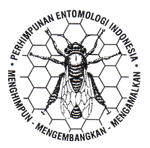Pola kunjungan serangga liar dan efek penambahan koloni Trigona (Tetragonula) laeviceps Smith pada penyerbukan kabocha (Cucurbita maxima)
DOI:
https://doi.org/10.5994/jei.14.2.69Keywords:
crops, fruit production, insect pollinators, reproduction successAbstract
Insects hold important role in pollination of many crops. However, studies on pollination in Indonesia could be considered rare. This study focussed on obtaining the basic information of wild pollinators and the effect Trigona (Tetragonula) laeviceps Smith innundation release to the production and quality of pumpkin (C. maxima) in traditional farming system. Observations were carried out from 07:00 to 15:00 during flowering period for 3 weeks. Sampling area was divided into three plots : open pollination + T. laeviceps (OPT), open pollination (OP), and hand pollination (HP). Pollination was assessed by three main parameters, which were visitation pattern, plant reproductive success, and fruit quality. Visitation pattern was assessed by measuring frequency and duration of pollinator visits, the plant reproductive success by fruit set and number of seed produced; while fruit quality by diameter, weight, and number of fruit produced/plant. We recorded different visitation pattern in which wild pollinator preferred to visit flowers in the morning while T. laeviceps preferred to visit from noon to afternoon. This pattern could be relate to difference in thermal tolerance among pollinators. There were significant differences among fruit set produced in OPT (80%), OP (65%), and HP (38.3%) (F2,35 = 19,907, P = 0,000). Number of seeds and fruit quality produced in OPT and OP much higher than HP while number of fruits produced in OPT significantly higher that OP and HP. Low pollination success in HP showed pollination process in pumpkin highly depend on pollination time. Thus, pollination by bees in pumpkin hard to be replace by human and variation of visit provided by T. laeviceps produce positive effect to pumpkin.
Downloads
Downloads
Additional Files
Published
How to Cite
Issue
Section
License
Authors who publish with this journal agree to the following terms:
- Authors retain copyright and grant the journal right of first publication with the work simultaneously licensed under a Creative Commons Attribution 4.0 International License that allows others to share the work with an acknowledgement of the work's authorship and initial publication in this journal.
- Authors are able to enter into separate, additional contractual arrangements for the non-exclusive distribution of the journal's published version of the work (e.g., post it to an institutional repository or publish it in a book), with an acknowledgement of its initial publication in this journal.
- Authors are permitted and encouraged to post their work online (e.g., in institutional repositories or on their website) prior to and during the submission process, as it can lead to productive exchanges, as well as earlier and greater citation of published work (See The Effect of Open Access).








